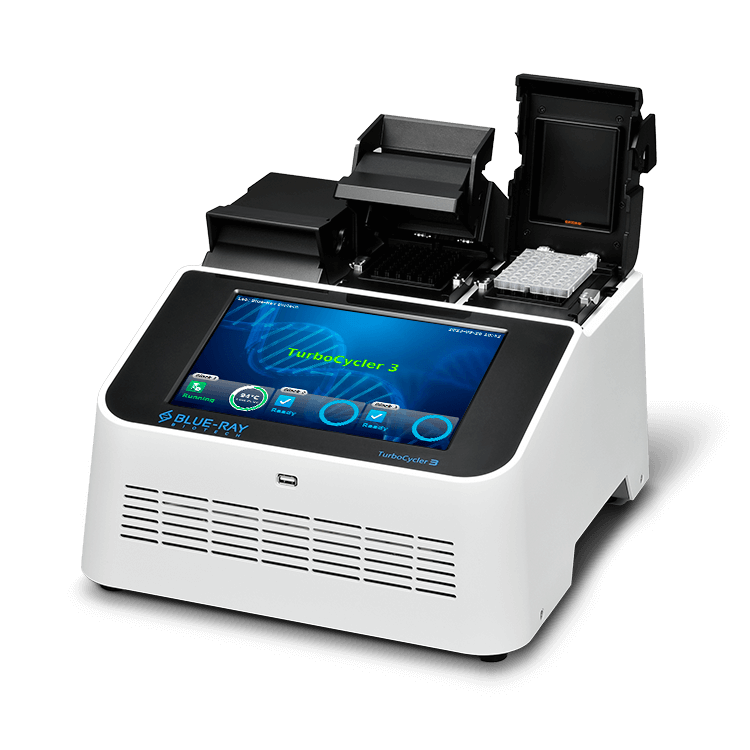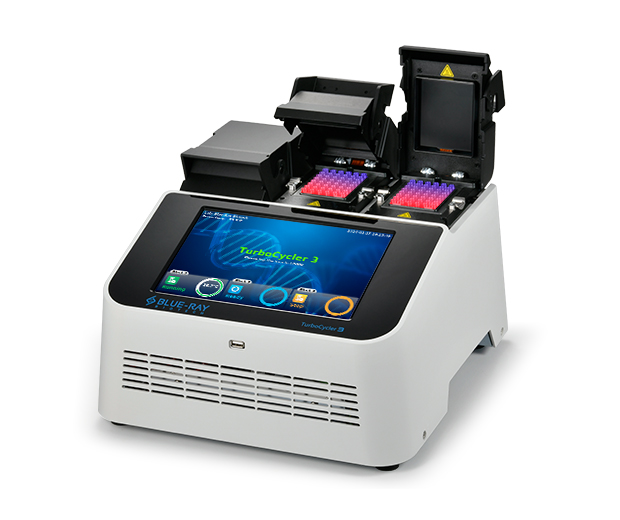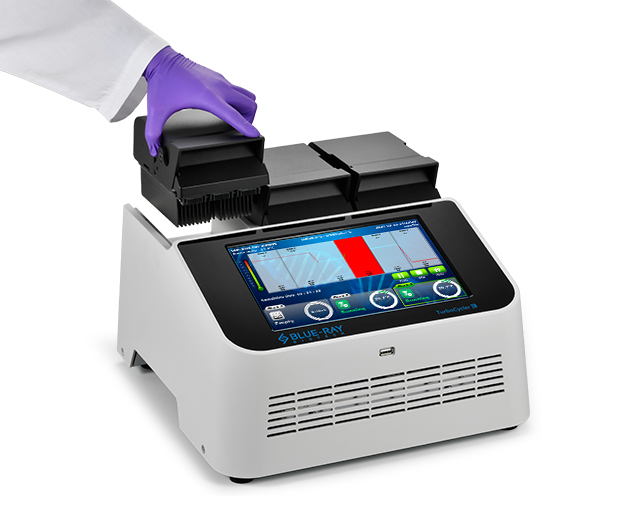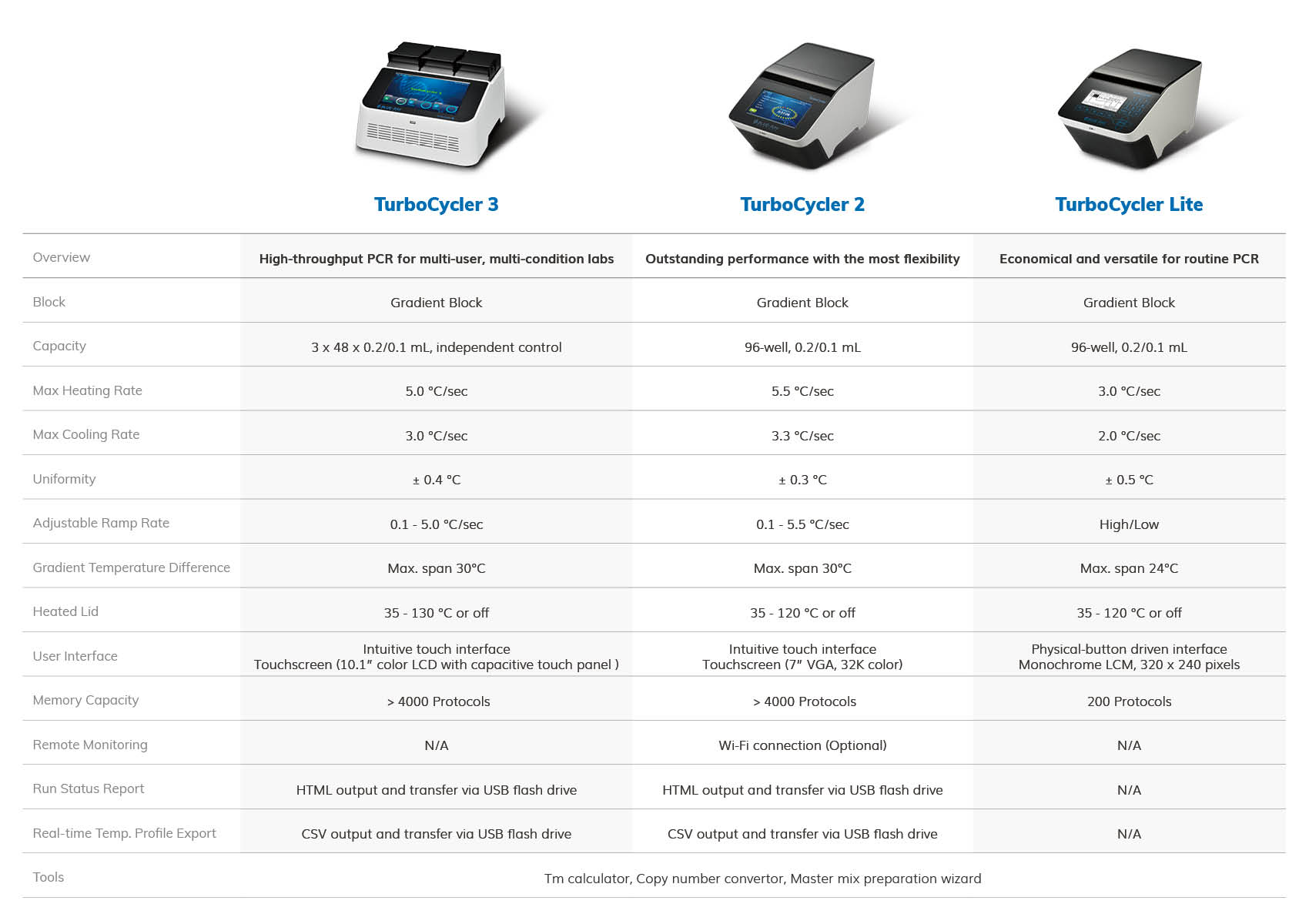Industry-first 8-zone gradient
Precise 8-zone temperature optimization per block, accelerating protocol development for research labs and reagent manufacturing.
High-Throughput Triple-Block Gradient PCR Thermal Cycler
TurboCycler 3 is the most powerful high-throughput PCR thermal cycler in its class. Run 3 independent experiments (3x48 samples) simultaneously with unmatched flexibility. Fast gradient optimization and advanced ramp rate control tailor PCR conditions for maximized efficiency. These features unite to boost your research throughput.

Triple-Block Flexibility
Three distinct PCR protocols can be run at the same time, perfect for multi-user environments and diverse experiments with low samples.
High-Throughput Efficiency
Maximize throughput with up to 3 x 48 x 0.1/0.2 ml samples.
Fast Gradient Optimization
PCR conditions across the three independent blocks are easily adjusted and range from 30 to 100 °C with a maximum span of 30 °C.
Advanced Ramp Rate Control
Ramp rate can be adjusted from 0.1 to 5.0 °C/sec, to accommodate different assays including CRISPR-related experiments.
Intuitive Operation
Effortless programming on a large 10.1” color touch screen with a user-friendly interface.
Continuous Reliability: Zero Downtime
Each of the three independent block modules can be independently calibrated to ensure uninterrupted operation during maintenance.

Precise 8-zone temperature optimization per block, accelerating protocol development for research labs and reagent manufacturing.

Independent blocks ensure uninterrupted operation during maintenance.

* Specifications are subject to change without prior notice.
The low-profile PCR vessel design reduces the overhead space above the reaction solution inside the vessel.
During thermal cycling, water in the solutions evaporates and fills the overhead space. This causes a concentration increase in the reacting solution.
The smaller the overhead space, the smaller the amount of evaporated water and concentration change in the solution. This is especially helpful when low volume reaction mixtures are being used.
In general, the low-profile PCR vessels are 5 mm shorter in height than the regular PCR vessels.
For standard PCR vessels, use the frame and set the lid heat to 105°C to balance the pressure from the lid heater.
For low-profile PCR vessels, use the compressor mat and set the lid heat to 130°C to maintain the pressure in the vessels.
Lid heating prevents severe condensation in the PCR tubes during the reaction.
The amount of evaporation is related to the sealing of the PCR vessels. A firm pressure on the lid will help maintain the integrity of the seal and prevent evaporation.
The lid temperature does not cycle and the competitive units do not cycle either.
When the heating block temperature drops below 30°C, the lid heater is turned off and the temperature of the lid decreases gradually. Competitive units also do this.
The temperature difference between the tube and the cycler causes condensation inside the tube. The tube temperature might remain at 4°C for a long time at the end of a run. This happens with all cyclers. It is like a bottle of water being put into a refrigerator; water always condenses in the neck.
The amount of water lost to the environment from a reaction vessel by evaporation depends on the integrity of the seal.
If the seal or the vessel cannot withstand the temperature cycling during the run, there may be deformation. This deformation may be serious enough to tear off the seal. Plates and seals of poor quality may deform enough to disrupt the seal. Low quality consumables should be avoided. The plates and seals must remain undeformed for the entire run.
The lid of the cycler needs to be heated to the proper temperature before the block starts to heat.
The delay will depend on the lid temperature setting, the room temperature, and how the compression mat has been used. Heating of the lid usually takes between 2 to 8 minutes.
When the power comes back on again after a “power-failure-during-a-run” event, the unit will start up and continue where it had stopped and run until the end of the protocol. This will happen as long as the power switch has not been touched in the meantime.
Also, if the power stays off for a long time, there will be a short delay (after the power comes back on) before the unit starts again. This is because it might take a minute or two for the lid to get back up to the right temperature.
After the lid module reaches its setting temperature, the protocol will be continued. This “auto-restart after power outage” function has been specifically designed to protect the PCR experiment.
Yes! But we do not recommend this be done very often.
Running your cycler overnight at 4°C can potentially reduce the life cycle of the instrument. In most applications, 16°C instead of 4°C for overnight storage can protect your DNA sample very well.
Yes! The ramping rate of TurboCycler 3 can be adjusted from 0.1°C to 5.0°C.
There are four different temperature settings for the lid:
1. 130°C (for use with low-profile vessels + compression mat), with an extra 3 minutes of pre-heat
2. 105°C
3. Heater off
4. Any temperature between 35°C - 130°C
The three blocks of TurboCycler 3 are interchangeable, which indicates you can switch blocks to random positions. Moreover, TurboCycler 3 can normally operate with 1 or 2 block(s) absent. If any block requires maintenance, just send it to your local Blue-Ray distributor.
The storage limits are:
- Protocol: >4000 sets
- History: 50 sets
- User folder: 100 sets
When the storage of protocols has reached the limit, a message will remind the user to delete some protocols. The system will not overwrite existing protocols.
However, when history storage reaches its limit, new histories will over-write the oldest. However, the user can set a reminder that shows when history storage gets close to the limit.
Each heating block has its individual heating element, heat sink, electric fan, ventilation channel, etc., so they will not interact with each other.
- Block mode: Enables system operation with maximum temperature control based on the actual block temperature regardless of the sample temperature. This mode is designed to mimic the control algorithm used in most early model thermal cyclers.
- Sample mode: Enables system operation with simulated temperature control. Users are required to input the sample volume: 5-100μl. In this mode, the temperature control algorithm will estimate the sample temperature based on the block temperature and sample volume. This is the mode recommended for normal operation.